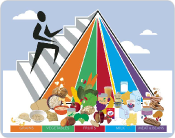Nutrition Facts
Nutrition data
& nutritional facts

Know what you eat
Search for and compare the detailed nutritional data and nutrient analysis of thousands of foods and ingredients that you eat.
Browse by food group
General Nutrient Content Guidelines
Wondering how does food labeling work or how to read food labeling?
Discover what do nutrition claims mean, when can nutritional claims be made and what are nutritional claims on food labels.
Food labeling definitions
- Free
-
What does fat free really mean?
The term "free" means that a product contains no amount of, or only trivial or "physiologically inconsequential" amounts of, one or more of these components: fat, saturated fat, cholesterol, sodium, sugars, and calories.
For example, "calorie-free" means fewer than 5 calories per serving, and "sugar-free" and "fat-free" both mean less than 0.5 g per serving.
Synonyms for "free" include "without", "no" and "zero". A synonym for fat-free milk is "skim".
- Low
-
What does low fat mean?
The term "low" can be used on foods that can be eaten frequently without exceeding dietary guidelines for one or more of these components: fat, saturated fat, cholesterol, sodium, and calories. Thus, descriptors are defined as follows:
- low-fat
3 g or less per serving
- low-saturated fat
1 g or less per serving
- low-sodium
140 mg or less per serving
- very low sodium
35 mg or less per serving
- low-cholesterol
20 mg or less and 2 g or less of saturated fat per serving
- low-calorie
40 calories or less per serving
- Lean and extra lean
- lean
less than 10 g fat, 4.5 g or less saturated fat, and less than 95 mg cholesterol per serving and per 100 g.
- extra lean
less than 5 g fat, less than 2 g saturated fat, and less than 95 mg cholesterol per serving and per 100 g.
- High
This term can be used if the food contains 20 percent or more of the Daily Value for a particular nutrient in a serving.
- Good source
This term means that one serving of a food contains 10 to 19 percent of the Daily Value for a particular nutrient.
- Reduced
-
This term means that a nutritionally altered product contains at least 25 percent less of a nutrient or of calories than the regular, or reference, product.
However, a reduced claim can't be made on a product if its reference food already meets the requirement for a "low" claim.
- Less
-
This term means that a food, whether altered or not, contains 25 percent less of a nutrient or of calories than the reference food.
For example, pretzels that have 25 percent less fat than potato chips could carry a "less" claim. "Fewer" is an acceptable synonym.
- Light
This descriptor can mean two things:
that a nutritionally altered product contains one-third fewer calories or half the fat of the reference food. If the food derives 50 percent or more of its calories from fat, the reduction must be 50 percent of the fat.
that the sodium content of a low-calorie, low-fat food has been reduced by 50 percent. In addition, "light in sodium" may be used on food in which the sodium content has been reduced by at least 50 percent.
These terms can be used to describe the fat content of meat, poultry, seafood, and game meats.
Healthy
A "healthy" food must be low in fat and saturated fat and contain limited amounts of cholesterol and sodium.
In addition, if it's a single-item food, it must provide at least 10 percent of one or more of vitamins A or C, iron, calcium, protein, or fiber.
Exempt from this "10-percent" rule are certain raw, canned and frozen fruits and vegetables and certain cereal-grain products.
These foods can be labeled "healthy," if they do not contain ingredients that change the nutritional profile, and, in the case of enriched grain products, conform to standards of identity, which call for certain required ingredients.
If it's a meal-type product, such as frozen entrees and multi-course frozen dinners, it must provide 10 percent of two or three of these vitamins or minerals or of protein or fiber, in addition to meeting the other criteria.
The sodium content cannot exceed 360 mg per serving for individual foods and 480 mg per serving for meal-type products.
ar: 2.85